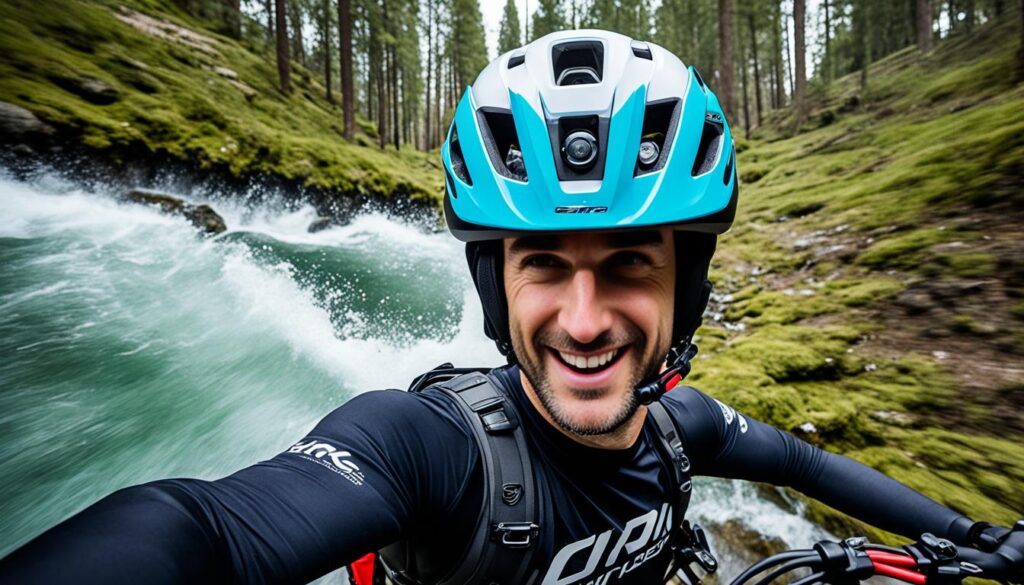
Are you an adventure enthusiast who loves capturing your thrilling moments on video? If so, you may be considering mounting a helmet camera for a first-person perspective. But with so many mounting options available, how do you choose the best one?
In this article, we will explore the pros and cons of different helmet camera mounting options, so you can make an informed decision that suits your needs and preferences. Whether you’re a motorcyclist, snowboarder, or cyclist, finding the right helmet camera mount can make all the difference in capturing the perfect shot.
So, let’s dive in and discover the advantages and challenges of each mounting method. Are you ready to find out which one will take your footage to the next level?
Key Takeaways:
- Chin mounts offer even weight distribution and minimize wind drag, providing smoother footage.
- The ProShot Helmet Cam Mounting System offers unique compatibility and centered chin placement.
- The SoPro Mount and TELESIN Helmet Chin Mount offer affordable options with easy removability.
- 3D printed mounts should be avoided due to potential safety risks.
- Consider your helmet type, functionality, and personal preferences when selecting a helmet camera mount.
The Pros of Helmet Chin Mounts
When it comes to mounting your helmet camera, helmet chin mounts offer several benefits that make them a popular choice among users. With their unique design and functionality, these mounts provide a reliable and convenient solution for capturing your action-packed adventures.
Even Weight Distribution
One of the key advantages of helmet chin mounts is their ability to evenly distribute the weight of your camera. By attaching the mount to the center of your chin area, the weight is balanced and does not cause discomfort or strain on one side of your helmet. This ensures a more comfortable and stable experience, allowing you to focus on your activities without distraction.
Minimized Wind Drag
Helmet chin mounts are strategically positioned to minimize wind drag during your activities. Placing the camera at the front and center of your helmet reduces its exposure to air resistance, resulting in smoother footage. This allows you to capture clear and steady images or videos without the interference of wind turbulence.
Flexible and Customizable
Many helmet chin mounts are crafted with flexibility in mind. They can be molded and adjusted to fit various helmet shapes and sizes, ensuring a secure and snug fit. This versatility allows you to use the mount with different helmets, eliminating the need for multiple camera mounting systems.
Strong Adhesive Attachment
Helmet chin mounts often utilize strong adhesive solutions, such as 3M VHB (Very High Bond) tape, for secure attachment. This adhesive is known for its durability and reliability, providing a strong bond between the mount and your helmet. With this robust attachment, you can have peace of mind knowing that your camera is securely mounted and won’t detach during your adventures.
Aesthetic Design and Vibration Dampening
In addition to their functional benefits, helmet chin mounts often boast an aesthetic design that seamlessly integrates with your helmet. They are designed to enhance the overall look of your gear while providing practical functionality. Furthermore, these mounts act as vibration dampeners, reducing the impact of vibrations and bumps on your footage, resulting in smoother, more professional-looking videos.
Overall, helmet chin mounts offer a range of advantages that make them a popular choice for helmet camera mounting. From the even weight distribution and minimized wind drag to the flexibility and strong adhesive attachment, these mounts provide a reliable and convenient solution for capturing your adventures. Furthermore, their attractive design and vibration dampening properties enhance the overall user experience, ensuring high-quality footage. Consider investing in a helmet chin mount to unlock the full potential of your helmet camera.
The Cons of Helmet Chin Mounts
Despite their many advantages, chin mounts do have some drawbacks. It’s important to be aware of these limitations before choosing a chin mount for your helmet camera.
Semi-Permanent Attachment
One of the main drawbacks of chin mounts is that they are semi-permanent. Once attached to your helmet, they are not easily removable. This can be problematic if you want to switch between different mounting options or if you need to remove the mount for any reason. Chin mounts typically use strong adhesive, such as 3M VHB, to ensure a secure attachment, but this also makes them more difficult to remove.
Challenges with Certain Helmet Designs
Another limitation of chin mounts is that they may not be suitable for all helmet models. Some helmets have a crease down the center, which can make it challenging to properly attach a chin mount. The crease can affect the stability and security of the mount, potentially compromising the safety of your camera. Additionally, certain helmet designs or structures may not have sufficient space or compatibility for chin mounts. It’s crucial to consider your helmet’s design and compatibility before opting for a chin mount.
To summarize, chin mounts offer several benefits, but they also have some drawbacks. They provide a center chin placement for even weight distribution and minimal wind drag. However, they are semi-permanent and can be difficult to remove, especially from helmets with a center crease. Additionally, certain helmet models may not be suitable for chin mounts due to their design or structure. Make sure to consider these factors before deciding whether a chin mount is the right attachment method for your helmet camera.
ProShot Helmet Cam Mounting System
The ProShot Helmet Cam Mounting System is a reliable and unique option for mounting your helmet camera. Utilizing 3M Dual-Lock adhesive, this mount offers a secure and sturdy attachment to your helmet. It is specifically designed for motocross style helmets and features a triple loop female connector, ensuring easy compatibility with GoPro cameras. The mount is centered on the chin, providing a balanced placement for optimal stability and footage quality. Additionally, the ProShot mount includes ventilation holes, allowing for better airflow and reducing discomfort during use.
While the ProShot Helmet Cam Mounting System offers several advantages, it’s important to consider a few potential drawbacks. The mount itself can be quite bulky, which may affect the overall aesthetics and feel of your helmet. Additionally, the Dual-Lock adhesive used can be semi-permanent or difficult to remove, requiring careful consideration before attaching it to your helmet. Overall, the ProShot Helmet Cam Mounting System is an innovative solution for helmet camera rig options, with its unique features and compatibility.
ProShot Helmet Cam Mounting System Features:
- 3M Dual-Lock adhesive for secure attachment
- Compatible with motocross style helmets
- Triple loop female connector for easy compatibility with GoPro cameras
- Centered on the chin for balanced weight distribution
- Ventilation holes for added comfort and airflow
ProShot Helmet Cam Mounting System Pros:
“The ProShot mount offers a secure and stable attachment for your helmet camera. Its centered chin placement ensures balanced weight distribution and smoother footage. The ventilation holes provide added comfort during use.” – HelmetCamExpert
ProShot Helmet Cam Mounting System Cons:
“The ProShot mount can be bulky and potentially affect the aesthetics of your helmet. Additionally, the Dual-Lock adhesive used may be semi-permanent or difficult to remove.” – HelmetMountsReview
Overall, the ProShot Helmet Cam Mounting System presents a unique option in the Helmet camera accessories comparison. Its compatibility, secure attachment, and centered placement make it a popular choice among helmet camera enthusiasts. However, considerations should be made regarding its size and adhesive characteristics. It’s essential to assess your specific needs and preferences before deciding on the best helmet camera rig option for you.
| Pros | Cons |
|---|---|
| Secure and stable attachment | Bulky and potentially affects helmet aesthetics |
| Centered chin placement for balanced weight distribution | Dual-Lock adhesive may be semi-permanent or difficult to remove |
| Ventilation holes for added comfort |
SoPro Mount
The SoPro Mount is a popular choice for helmet camera mounting. It offers a versatile and convenient solution for riders who value easy installation and removal. This mounting option utilizes securing straps that tie through the visor/goggle area and the front chin area, ensuring a secure fit while allowing for quick adjustments and positioning. By utilizing these straps, the SoPro Mount offers a non-permanent solution that can be easily removed when not in use.
The SoPro Mount is constructed from durable aluminum, providing a strong foundation for your helmet camera. To ensure added protection and stability, the mount is padded with foam, which acts as a shock absorber. This feature minimizes vibrations and helps to capture smooth and stable footage of your adventures.
While the SoPro Mount offers numerous benefits, it’s important to note that it may not be suitable for helmets with visors. The strap placement and size of the mount can interfere with the visor’s functionality or obstruct your field of vision. Therefore, if your helmet has a visor, it’s recommended to consider alternative mounting options.
Advantages of the SoPro Mount:
- Easily removable and non-permanent
- Durable construction with aluminum
- Padded with foam for added protection
- Secure strap system for easy adjustments
Disadvantages of the SoPro Mount:
- May not be suitable for helmets with visors
- Larger size compared to other mounting options
When considering the best helmet camera mount setup for your needs, the SoPro Mount offers a convenient and reliable solution. Its removable and adjustable strap system, along with its durable construction, make it a popular choice among riders. However, make sure to take into account the compatibility with your helmet’s design and the size of the mount before making your final decision.

TELESIN Helmet Chin Mount
The TELESIN Helmet Chin Mount is a budget-friendly option for mounting your helmet camera. This versatile mount uses the same securing strap method as the SoPro Mount, making it easily removable and adjustable to fit a variety of helmet sizes and shapes. Despite its affordable price point, the TELESIN mount does not compromise on quality, providing a reliable and secure attachment for your camera.
Designed to be lightweight and durable, the TELESIN Chin Mount is made from high-quality materials that can withstand the rigors of outdoor activities. It offers a stable and secure platform for capturing your adventures from a unique perspective.
One of the key advantages of the TELESIN Helmet Chin Mount is its affordability, making it accessible to a wide range of users. Whether you are a professional athlete or a casual adventurer, this mount provides a cost-effective solution for your helmet camera rig.
However, it’s important to note that the TELESIN Chin Mount may not be suitable for helmets with visors, as the mounting position may interfere with the visor’s functionality. It is recommended to check the compatibility of your helmet before purchasing this mount.
Additionally, there have been claims of potential patent infringement related to the TELESIN Chin Mount. While this may not directly impact its performance, it’s important to be aware of the legal implications associated with the product.

In summary, the TELESIN Helmet Chin Mount offers a budget-friendly option for mounting your helmet camera. With its easy removability, durability, and affordable price, it provides an attractive choice for those looking to capture their adventures from a unique angle. However, it’s important to consider its compatibility with helmets and the potential legal concerns associated with this mount. By evaluating these factors, you can make an informed decision to create the best helmet cam mount setup for your needs.
3D Printed Mounts
When it comes to helmet camera mounting solutions, 3D printed mounts may seem like an innovative and customizable option. However, it is important to tread with caution before considering this mounting method.
3D printed mounts are not recommended for helmet camera mounting for several reasons. Firstly, they often utilize cheap filament that is not weather-resistant. Over time, exposure to the elements can cause the mount to weaken, compromising its strength and stability.
Furthermore, the quality and adhesive used in 3D printed mounts can be questionable. The materials used may not provide the necessary durability and reliability required for securely mounting a helmet camera. This can lead to potential issues and safety risks, jeopardizing the integrity of your camera and helmet.
In order to ensure the best helmet camera mounting experience, it is advisable to explore other options that have been tested and proven to offer superior performance and reliability.
Comparing Helmet Camera Mounting Solutions
| Mount Type | Advantages | Disadvantages |
|---|---|---|
| Chin Mounts | – Even weight distribution | – Semi-permanent attachment |
| ProShot Helmet Cam Mounting System | – Unique attachment method | – Bulky design, difficult to remove |
| SoPro Mount | – Easy removability | – Not suitable for helmets with visors |
| TELESIN Helmet Chin Mount | – Affordable option | – Not suitable for helmets with visors |
As the table illustrates, there are various helmet camera mounting solutions available, each with its own set of advantages and disadvantages. By carefully considering these options, you can select the best mounting solution that meets your specific needs and requirements.
Conclusion
When it comes to helmet camera mounting, it’s crucial to weigh the pros and cons of each method to find the ideal solution for your needs. Chin mounts offer the advantage of a center chin placement, providing even weight distribution and minimizing wind drag for smoother footage. However, their semi-permanent nature and difficulty in removal may be a drawback for some users.
The ProShot Helmet Cam Mounting System presents a unique approach with its Dual-Lock adhesive, offering secure attachment and compatibility with GoPro cameras. Meanwhile, the SoPro Mount and TELESIN Helmet Chin Mount provide affordable options that are easily removable, ensuring convenience for users. It’s important to note that 3D printed mounts should be avoided due to potential safety risks and issues with their construction and adhesive quality.
By carefully considering these helmet camera rig options, you can make an informed decision that best suits your preferences and filming requirements. Whether you opt for the stability of a chin mount or the versatility of a ProShot system, keep these mounting tips in mind to enhance your helmet camera experience and capture remarkable moments while ensuring your safety on the go.
Source Links
- https://motoradds.com/blogs/daily-read/5-best-helmet-chin-mounts-ranked-pros-and-cons
- https://www.bennetts.co.uk/bikesocial/news-and-views/news/2016/january/study-shows-helmet-cameras-are-safer-than-first-thought
- https://www.vitalmtb.com/forums/The-Hub,2/Camera-Mounts-on-Helmets-Potential-Safety-Concern,8206

Meet James Smith, affectionately known by friends as ‘Biker Smith’, your go-to expert at ‘Best HD Helmet Camera’. At 35, living in the USA, James embodies the spirit of adventure. His life is a thrilling ride, powered by his Harley Davidson Softail and BMW S 1000 RR, with his girlfriend as his favorite travel companion. A software developer by profession, James’s heart beats for the open road, making him a full-time traveler at heart. His passion for biking and technology merges seamlessly on this platform. Recognizing a gap in discussions around helmet cameras, he founded this blog to educate and inspire fellow enthusiasts. His mission? To elevate your riding experience with the best HD helmet camera insights, backed by firsthand experiences, rigorous testing, and a genuine love for the ride. Trust James to guide you through the world of helmet cameras, where quality, innovation, and safety ride together.